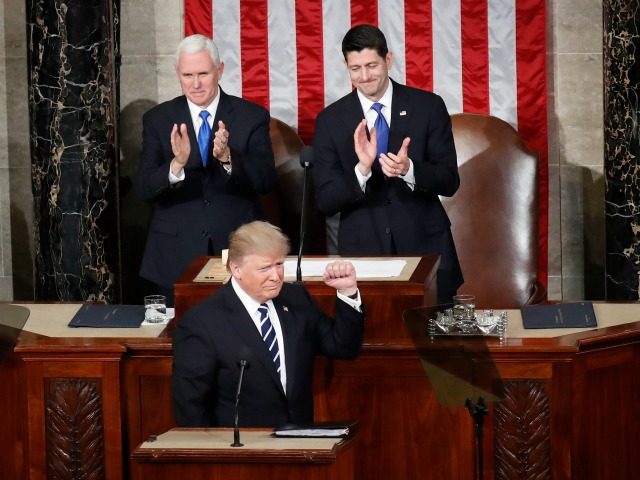President Donald Trump called for a huge overhaul of the nation’s immigration rules to reduce the huge inflow of low-skill, welfare-dependent immigrants, but perhaps also to increase the inflow of productivity-boosting white-collar immigrants.
In his Feb. 28 speech to the joint session of Congress, he declared:
Nations around the world, like Canada, Australia and many others –- have a merit-based immigration system. It is a basic principle that those seeking to enter a country ought to be able to support themselves financially. Yet, in America, we do not enforce this rule, straining the very public resources that our poorest citizens rely upon. According to the National Academy of Sciences, our current immigration system costs America’s taxpayers many billions of dollars a year.
Switching away from this current system of lower-skilled immigration, and instead adopting a merit-based system, will have many benefits: it will save countless dollars, raise workers’ wages, and help struggling families –- including immigrant families –- enter the middle class.
I believe that real and positive immigration reform is possible, as long as we focus on the following goals: to improve jobs and wages for Americans, to strengthen our nation’s security, and to restore respect for our laws.
Trump’s proposed shift to “a merit-based immigration system” would reduce the inflow of unskilled migrants, but perhaps also raise the inflow of skilled migrants.
Two GOP Senators are also proposing a reduction in low-skill immigration and a rise in high-skilled immigration.
Any policy shift to reduce l0w-skilled migration would likely be opposed by Democrats, by Wall Street investors and by the many member companies in the U.S. Chamber of Commerce, all of whom gain from the huge annual inflow of roughly 800,000 salary-cutting, welfare-spending unskilled migrants.
Most of these unskilled immigrants are the extended family relations of prior unskilled immigrants from South America or Asia, and they tend to push less skilled Americans — white, Latino and African-American — out of the job market. This family based inflow is strongly supported by ethnic political groups, such as the National Council of La Raza and by various Arab, Pakistani, and Islamic political groups.
Trump suggested he opposed migrants who do not integrate into Americans’ society, saying “those given the high honor of admission to the United States should support this country and love its people and its values.”
Trump reemphasized his frequent argument that curbs on illegal immigration will help raise Americans’ wages. “By finally enforcing our immigration laws, we will raise wages, help the unemployed, save billions of dollars, and make our communities safer for everyone,” he said, adding “we want all Americans to succeed –- but that can’t happen in an environment of lawless chaos.”
In contrast to unskilled migration, the annual inflow of university educated legal immigrants is much smaller, at perhaps 200,000 professionals per year.
Nonetheless, these skilled migrants compete for white-collar jobs against the roughly 800,000 young Americans who graduate each year with degrees in business, healthcare, technology, and science.
The white-collar immigrant labor supply is augmented by the resident population of at least 1 million white-collar contract workers who hold long-term H-1B visas or work permits. Roughly 650,000 foreign H-1B workers are employed in a wide variety of white-collar jobs in the United States, including roughly 100,000 as academics, teachers, doctors, therapists, scientists, and designers at American universities. Other visa programs boost the number of resident foreign professionals to at least 1 million.
The H-1B program and other visa programs are used by many prestigious American companies, including Comcast, Carnival, Disney, McDonald’s, Caterpillar. and Uber. Also, many lesser-known U.S. companies hire Indian workers from Indian-owned outsourcing firms.
The large supply of foreign graduates — either immigrants or guest workers — pushes many middle-aged American professionals out of their careers and pushes younger American graduates into different careers with lower salaries.
The sidelined American professionals and their families have been a huge source of support for Trump because of Trump’s repeated opposition to the H-1B program. If Trump is willing to increase the inflow of skilled white-collar workers, he risks losing the support of many middle-class voters during the 2018 and 2020 elections.
If Trump is willing to increase the inflow of white-collar skilled workers, he risks losing the support of many middle-class voters during the 2018 and 2020 elections.
But any debate about higher levels of skilled immigration might also create broad white-collar opposition to cheap-labor immigration programs, so helping Trump build public support for a reduction in overall immigration levels.
Name-brand companies and universities lobby year-round for a greater supply of foreign white-collar labor. For example, in 2013, companies and universities persuaded senators to include a provision in the pending “Comprehensive Immigration Reform” bill which would have allowed an unlimited inflow of salary-cutting foreign graduates into the white-collar job sites. In 2017, these business groups are opposing campaign proposals by Trump to reform the H-1B programs, which has created a resident population of roughly 650,000 white-collar contract workers, including 100,000 employed by universities.
For example, in 2013, companies and universities persuaded senators to include a provision in the pending “Comprehensive Immigration Reform” bill which would have allowed an unlimited inflow of salary-cutting foreign graduates into the white-collar job sites. In 2017, these business groups are opposing campaign proposals by Trump to reform the H-1B programs, which has created a resident population of roughly 650,000 white-collar contract workers, including 100,000 contract workers employed by universities.

COMMENTS
Please let us know if you're having issues with commenting.